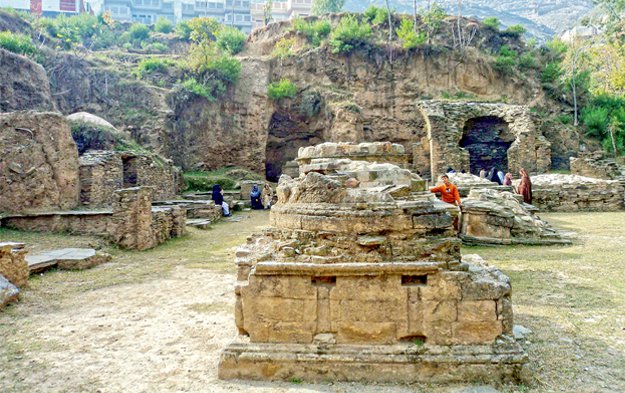History of Swat
Buddhist Era in Swat
The Indo-Greeks (those Greek rulers who occupied the seats in India after the downfall of the Mauryas) and the Scythian or had its relations and economic ties with them. Menander, among the Indo-Greeks occupied the Swat valley. It was later handed over to a sub-king Antimachus II. At the death of Menander his wife Agathocleia ruled at first in her own right and later jointly with her son. In order to counterbalance the influence of Antimachus- who assumed independence at Arrachosia (around Ghazni) –and other descendants of Diodotus, she appointed Zoilus I, a member of her family, as a sub- king in the Swat valley. Zoilus ruled briefly in Swat; for he was went to Arachosia, on the death of Antimachus II, to regain it. After Zoilus I, the known sub-king of Swat is Apollodutus who was overthrown by the Saka chief Maues.

Another Scythian tribe, the Sai of the Upper lli and different from the Scythians of the Jaxatas valley for other areas west of them, also reached and occupied Swat and the adjoining area. It was soon after 100 B.C. that Maues, the first known Saka King in India, followed the Indo-Greek rulers in Swat valley and Gandhara by overthrowing Apolodotus from the area.
Kadphises I, leader of the Kushans who were from the nomads race of Central Asia, seized vast territories extended to the south of Kabul river and established his rule. During the reign of the Kushana dynasty in the west and south of Swat the factual position whether Swat became an integral part of the Kushana Empire or retained it own independent status is uncertain. It is most probable that Swat or its petty chiefs had been a tributary Kushana.


When the boundaries of theTurki Shahi kingdom of Kabul were extended from the border of Sistan to northern Punjab, in the middle of the seventh century A.D., Swat was annexed in the process in about 745. The Turkey Shahi kingdom of Kabul was overthrown by Yaqub bin Lais in 870. The Hindu Shahi dynasty established its rule after the downfall of the Turkey Shahis, and with the passage of time extended boundaries of its kingdom. Information about Swat of the Hindu Shahi reign is also scanty. Nevertheless the Bari Kot incription of the reign of Jayapaladeva found on a hill to the north of Bari Kot hints at Swat being a part of the Hindu Shahi or at least under their over-lordship at the time. However, the question that whether Swat remained an integral part of the Hindu Shahi kingdom or not, is not easy to settle.


When the Hindu Shahi rule was sweft away by the Muslim under Mahmood of Ghazna, Swat was also not spared. The Muslim attacked Swat (ca. A.D.1001-1002), it seems, after the defeat of Raja Jaipal and besieged the reigning Raja Geera near Udigram . The traditions and legends make a fantasy and romance of the fall of the fortress by stating that the fortress, after withstanding repeated assaults by the forces of Mahmud, finally surrendered when the King’s daughter, who was in love with one of Mahmud’s general, revealed the place from where the fort got its water supply. Consequently, the supply was cut down, which forced the garrison to fight.
After the occupation of the valley by the Muslims, people from deferent pukhtun tribes settled in Swat. They came to be known Swati Pukhtuns. They established their rule for centuries. Practically, they remained independent and out of the sphere of the neighbouring Muslims rulers of Afghanistan and India throughout their occupation.


The sixteenth century proved turning point in the history of Swat as the Yusufzai Pukhtun occupied the land. At that time, the last decade of the fifteen-century, Swat was in the possession of the Swati Pukhtuns and Sultan Uwais was its chief ruler. Though the Yusufzais established matrimonial relations with the Sultan, they were ambitious for the valley. They worked out their plan, foiled defensive measures of the Swaties by a stratagem and occupied Lower Swat. By the sixteenth century Lower Swat was in the possession of the Yusufzais.Their advance came to a halt for the time being.
The Yusufzais resumed their advance during the reign of Humayun, the Mughal ruler of India, and Sultan Uwais and most of the old Swati Pukhtuns were compelled to leave their possessions in Upper Swat. Upper Swat was taken by the yusufzais. Though the Yusufzai did not make their advance toward the mountainous area of the Swat Kohistan, they continue their inroads in the other bordering areas, they extended their occupation to the territories of Gwarband, Puran, Chakisar and Kanra as well.
While the Yusufzais gained footing in Swat, Babur made himself master of Kabul. Collision between the two sides was unavoidable, because one of Babur’s routs to India fell within the domain of the yusufzais. With the intentions of attacking the yusufzais, Babur marched for Swat and dismounted in between the water of Punjkora and united waters of Jandol and Bajawar. But he refrained from advancing in to Swat. Instead of arms he used diplomacy and tactics and left for Ashnaghar from Bajawar.

















0 comments